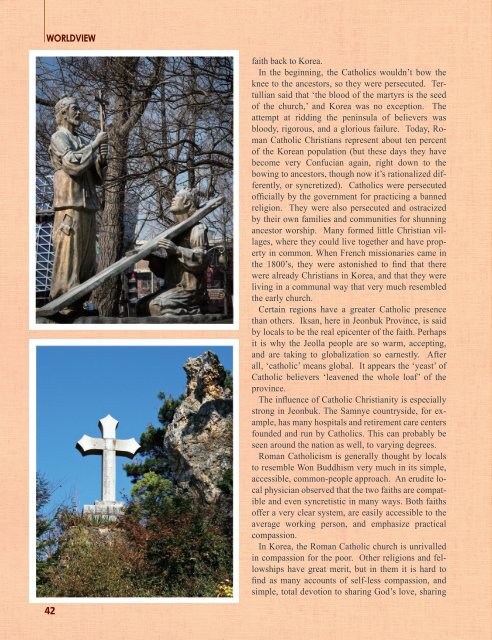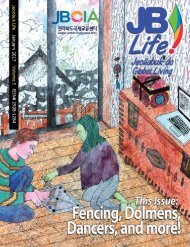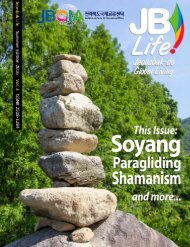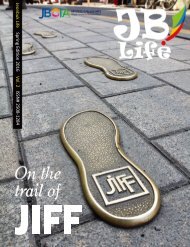JB Life March 2017
The Spring version of JB Life, North Jeolla's quarterly global lifestyle magazine.
The Spring version of JB Life, North Jeolla's quarterly global lifestyle magazine.
You also want an ePaper? Increase the reach of your titles
YUMPU automatically turns print PDFs into web optimized ePapers that Google loves.
WORLDVIEW<br />
faith back to Korea.<br />
In the beginning, the Catholics wouldn’t bow the<br />
knee to the ancestors, so they were persecuted. Tertullian<br />
said that ‘the blood of the martyrs is the seed<br />
of the church,’ and Korea was no exception. The<br />
attempt at ridding the peninsula of believers was<br />
bloody, rigorous, and a glorious failure. Today, Roman<br />
Catholic Christians represent about ten percent<br />
of the Korean population (but these days they have<br />
become very Confucian again, right down to the<br />
bowing to ancestors, though now it’s rationalized differently,<br />
or syncretized). Catholics were persecuted<br />
officially by the government for practicing a banned<br />
religion. They were also persecuted and ostracized<br />
by their own families and communities for shunning<br />
ancestor worship. Many formed little Christian villages,<br />
where they could live together and have property<br />
in common. When French missionaries came in<br />
the 1800’s, they were astonished to find that there<br />
were already Christians in Korea, and that they were<br />
living in a communal way that very much resembled<br />
the early church.<br />
Certain regions have a greater Catholic presence<br />
than others. Iksan, here in Jeonbuk Province, is said<br />
by locals to be the real epicenter of the faith. Perhaps<br />
it is why the Jeolla people are so warm, accepting,<br />
and are taking to globalization so earnestly. After<br />
all, ‘catholic’ means global. It appears the ‘yeast’ of<br />
Catholic believers ‘leavened the whole loaf’ of the<br />
province.<br />
The influence of Catholic Christianity is especially<br />
strong in Jeonbuk. The Samnye countryside, for example,<br />
has many hospitals and retirement care centers<br />
founded and run by Catholics. This can probably be<br />
seen around the nation as well, to varying degrees.<br />
Roman Catholicism is generally thought by locals<br />
to resemble Won Buddhism very much in its simple,<br />
accessible, common-people approach. An erudite local<br />
physician observed that the two faiths are compatible<br />
and even syncretistic in many ways. Both faiths<br />
offer a very clear system, are easily accessible to the<br />
average working person, and emphasize practical<br />
compassion.<br />
In Korea, the Roman Catholic church is unrivalled<br />
in compassion for the poor. Other religions and fellowships<br />
have great merit, but in them it is hard to<br />
find as many accounts of self-less compassion, and<br />
simple, total devotion to sharing God’s love, sharing<br />
property, sharing meals, sharing health care, and sharing<br />
time.<br />
The thesis of these articles is that all these religions<br />
and philosophies are to some degree syncretized into<br />
the Korean culture and mind.<br />
But more specifically, that the complex, liberal,<br />
thoughtful, Jeonbuk mentality isn’t the same as the<br />
other regions of Korea. This has been deeply impressed<br />
upon me by my older Korean friends, family,<br />
and colleagues, in interviews and conversations over<br />
the last dozen years. It is readily apparent in political<br />
history, and in the regionalisms that persist within<br />
Korea. Jeonbuk has been marginalized by the other<br />
regions of Korea for a thousand years, so it’s not the<br />
only reason for the difference, granted; but talking to<br />
the people, not surfing the web, is how this theory has<br />
been formed.<br />
(By this point, any astute reader is calling ‘bias.’ I’d<br />
like to note, parenthetically, that my background is<br />
ferociously Protestant. Indeed there was a bias; and<br />
it has been tenderized significantly by my time spent<br />
investigating Jeonbuk Catholics.)<br />
There is strong evidence to support the idea that the<br />
Catholic ingredient is much stronger in the local stew.<br />
Even if you do not subscribe doctrinally to some, or<br />
any, tenets of Roman Catholicism, its strong presence<br />
in the recipe still offers a most pleasant aroma.<br />
PHOTOS :<br />
PAGE 42-43 -- Jeondeong Cathedral, in<br />
Jeonju’s Hanok Village.<br />
LEFT -- Images of Catholic martyrdom outside<br />
Jeondong and the cross atop Martyr’s Mountain,<br />
a renowned Catholic site in Jeonju.<br />
RIGHT -- The inside of the Cathedral; the statue<br />
atop a small Catholic church in Dukjin-gu.<br />
[Photos by ANJEE DISANTO]<br />
42 Jeonbuk <strong>Life</strong> 43







